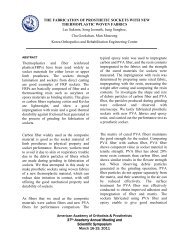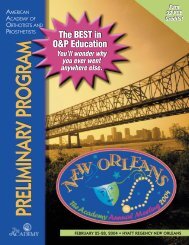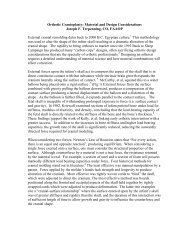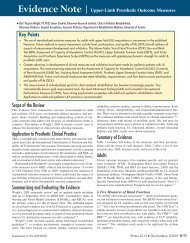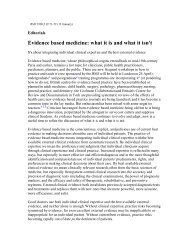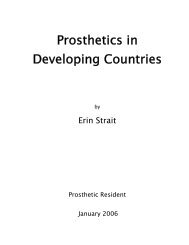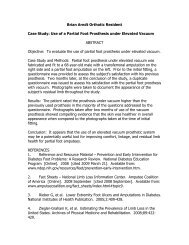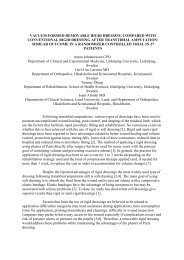Evidence Note: The Use of KAFOs and HKAFOs for Ambulation
Evidence Note: The Use of KAFOs and HKAFOs for Ambulation
Evidence Note: The Use of KAFOs and HKAFOs for Ambulation
You also want an ePaper? Increase the reach of your titles
YUMPU automatically turns print PDFs into web optimized ePapers that Google loves.
25. Lissens M, Peeraer L, Tirez B, et al. Advanced reciprocating gait orthosis (ARGO) in paraplegic patients (abstract). Eur J Phys Med Rehabil. 1993;3:147.<br />
26. Motloch WM. Principles <strong>of</strong> orthotic management <strong>for</strong> child <strong>and</strong> adult paraplegia <strong>and</strong> clinical experience with the Isocentric RGO. Paper presented at the 7th<br />
World Congress <strong>of</strong> the International Society <strong>for</strong> Prosthetics <strong>and</strong> Orthotics; June 28–July 3, 1992; Chicago, IL.<br />
27. Davidson H. <strong>The</strong> isocentric reciprocating gait orthosis. APO Newsletter. 1994;1:12–15.<br />
28. Winchester PK, Carollo JJ, Parekh RN, et al. A comparison <strong>of</strong> paraplegic gait per<strong>for</strong>mance using two types <strong>of</strong> reciprocating gait orthoses. Prosthet Orthot Int.<br />
1993;17:101–106.<br />
29. Fatone S. A review <strong>of</strong> the literature pertaining to <strong>KAFOs</strong> <strong>and</strong> H<strong>KAFOs</strong> <strong>for</strong> ambulation. J Prosthet Orthot. 2006;18:137–168.<br />
30. Ijzerman MJ, Baardman G, Hermens HJ, et al. Comparative trials on hybrid walking systems <strong>for</strong> people with paraplegia: an analysis <strong>of</strong> study methodology.<br />
Prosthet Orthot Int. 1999;23:260–273.<br />
31. Bakker JP, de Groot IJ, Beckerman H, et al. <strong>The</strong> effects <strong>of</strong> knee–ankle–foot orthoses in the treatment <strong>of</strong> Duchenne muscular dystrophy: review <strong>of</strong> the literature.<br />
Clin Rehabil. 2000;14:343–359.<br />
32. Lam T, Wolfe D, Hsieh J, et al. Lower Limb Rehabilitation Following Spinal Cord Injury. In: Eng J, Teasell R, Miller W, Wolfe D, Townson A, Hsieh J, Konnyu K,<br />
Connolly S, Foulon B, Aubut J, eds. Spinal Cord Injury Rehabilitation <strong>Evidence</strong>. Vancouver: SCI Solutions Network; 2008:6.1–6.41.<br />
33. American Academy <strong>of</strong> Orthotists <strong>and</strong> Prosthetists. Proceedings: Knee–Ankle–Foot Orthoses <strong>for</strong> <strong>Ambulation</strong>. Official Findings <strong>of</strong> the State-<strong>of</strong>-the-Science Conference;<br />
February 11–12, 2006; Chicago, IL.<br />
34. Franceschini M, Baratta S, Zampolini M, et al. Reciprocating gait orthoses: a multicenter study <strong>of</strong> their use by spinal cord injured patients. Arch Phys Med Rehabil.<br />
1997;78:582–586.<br />
35. Jaspers P, Peeraer L, Van Petegem W, Van der Perre G. <strong>The</strong> use <strong>of</strong> an advanced reciprocating gait orthosis by paraplegic individuals: a follow–up study. Spinal<br />
Cord. 1997;35:585–589.<br />
36. Nene A. Paraplegic locomotion: A review. Spinal Cord. 1996;34:507–524.<br />
37. Waters RL, Mulroy S. <strong>The</strong> energy expenditure <strong>of</strong> normal <strong>and</strong> pathologic gait. Gait Posture. 1999;9:207–231.<br />
38. Ijzerman MJ, Baardman G, Hermens HJ, et al. Speed dependence <strong>of</strong> crutch <strong>for</strong>ce <strong>and</strong> oxygen uptake: implications <strong>for</strong> design <strong>of</strong> comparative trials on orthoses<br />
<strong>for</strong> people with paraplegia. Arch Phys Med Rehabil. 1998;79:1408–1414.<br />
39. Ijzerman MJ, Baardman G, van H<strong>of</strong> MA, et al. Validity <strong>and</strong> reproducibility <strong>of</strong> crutch <strong>for</strong>ce <strong>and</strong> heart rate measurements to assess energy expenditure <strong>of</strong> paraplegic<br />
gait. Arch Phys Med Rehabil. 1999;80:1017–1023.<br />
40. Merritt JL, Yoshida MK. Knee–ankle–foot orthoses: indications <strong>and</strong> practical applications <strong>of</strong> long leg braces. Phys Med Rehabil State Art Rev. 2000;14:239–<br />
422.<br />
41. Waters RL, Yakura JS, Adkins RH. Gait per<strong>for</strong>mance after spinal cord injury. Clin Orthop. 1993;288:87–96.<br />
42. Clinkingbeard JR, Gersten JW, Hoehn D. Energy Cost <strong>of</strong> <strong>Ambulation</strong> in the Traumatic Paraplegic. Am J Phys Med. 1964;43:157–165.<br />
43. Merkel KD, Miller NE, Merritt JL. Energy expenditure in patients with low-, mid-, or high-thoracic paraplegia using Scott-Craig knee–ankle–foot orthoses. Mayo<br />
Clin Proc. 1985;60:165–168.<br />
44. Hirokawa S, Grimm M, Le T, et al. Energy consumption in paraplegic ambulation using the reciprocating gait orthosis <strong>and</strong> electric stimulation <strong>of</strong> the thigh muscles.<br />
Arch Phys Med Rehabil. 1990;71:687–694.<br />
45. Chantraine A, Crielaard JM, Onkelinx A, Pirnay F. Energy expenditure <strong>of</strong> ambulation in paraplegics: effects <strong>of</strong> long term use <strong>of</strong> bracing. Paraplegia.<br />
1984;22:173–181.<br />
46. Nene AV, Patrick JH. Energy cost <strong>of</strong> paraplegic locomotion with the ORLAU ParaWalker. Paraplegia 1989;27:5–18.<br />
47. Suga T, Kameyama O, Ogawa R, et al. Newly designed computer controlled knee–ankle–foot orthosis (Intelligent Orthosis). Prosthet Orthot Int. 1998;22:230–<br />
239.<br />
48. Tokuhara Y, Kameyama O, Kubota T, et al. Biomechanical study <strong>of</strong> gait using an intelligent brace. J Orthop Sci. 2000;5:342–348.<br />
49. Irby SE, Bernhardt KA, Kaufman KR. Gait changes over time in stance control orthosis users. Prosthet Orthot Int. 2007;31:353–361.<br />
50. Bernhardt KA, Irby SE, Kaufman KR. Consumer opinions <strong>of</strong> a stance control knee orthosis. Prosthet Orthot Int. 2006;30:246–256.<br />
51. Lehmann JF, Stonebridge JB. Knee lock device <strong>for</strong> knee ankle orthoses <strong>for</strong> spinal cord injured patients: an evaluation. Arch Phys Med Rehabil. 1978;59:207–<br />
211.<br />
52. Kagaya H, Shimada Y, Sato K, et al. An electrical knee lock system <strong>for</strong> functional electrical stimulation. Arch Phys Med. Rehabil. 1996;77:870–873.<br />
53. Kaufman KR, Irby SE, Mathewson JW, et al. Energy-efficient knee–ankle foot orthosis: a case study. J Prosthet Orthot. 1996;8(3):79.<br />
54. Irby SE, Kaufman KR, Wirta RW, Sutherl<strong>and</strong> DH. Optimization <strong>and</strong> application <strong>of</strong> a wrap-spring clutch to a dynamic knee–ankle–foot orthosis. IEEE Trans<br />
Rehabil Eng. 1999;7:130–134.<br />
55. McMillan A, Kendrick K, Michael J, et al. Preliminary evidence <strong>for</strong> effectiveness <strong>of</strong> a stance control orthosis. J Prosthet Ortho. 2004;16:6–15.<br />
56. Rietman JS, Goudsmit J, Meulemans D, et al. An automatic hinge system <strong>for</strong> leg orthoses. Prosthet Orthot Int. 2004;28:64–68.<br />
57. Yakimovich T, Lemaire ED, K<strong>of</strong>man J. Preliminary kinematic evaluation <strong>of</strong> a new stance-control knee–ankle–foot orthosis. Clin Biomech (Bristol, Avon).<br />
2006;21:1081–1089.<br />
58. Rasmussen A, Smith K, Damiano D. Biomechanical evaluation <strong>of</strong> the combination <strong>of</strong> bilateral stance-control knee–ankle–foot orthoses <strong>and</strong> a reciprocating gait<br />
orthosis in an adult with a spinal cord injury. J Prosthet Orthot. 2007;19:42–47.<br />
59. Moreno J, Brunetti F, Rocon E, Pons J. Immediate effects <strong>of</strong> a controllable knee ankle foot orthosis <strong>for</strong> functional compensation <strong>of</strong> gait in patients with proximal<br />
leg weakness. Med Biol Eng Comput. 2008 46:43–53.<br />
60. van Leerdam N, Kunst E. Die neue bienorthese UTX-Swing: normales gehen, kombiniert mit sicherem Stehen (New UTX-Swing orthosis: normal gait <strong>and</strong> safe<br />
st<strong>and</strong>ing) OrthopadieTechnik. 1999;6:506–515.<br />
61. Sarikaya S, Basaran A, Ortancil O, Balbaloglu O. A new modification <strong>of</strong> KAFO <strong>for</strong> assistance in knee extension. Disabil Rehabil Assist Technol 2007. 2:67–70.<br />
62. Irby SE, Kaufman KR, Mathewson JW, Sutherl<strong>and</strong> DH. Automatic control design <strong>for</strong> a dynamic knee-brace system. IEEE Trans Rehabil Eng. 1999;7:135–139.<br />
63. Yakimovich T, K<strong>of</strong>man J, Lemaire ED. Design <strong>and</strong> evaluation <strong>of</strong> a stance-control knee–ankle–foot orthosis knee joint. IEEE Trans Neur Sys Rehabil Eng.<br />
2006;14:361–369.<br />
64. Condie E, Campbell J, Martina J. Report <strong>of</strong> a consensus conference on the orthotic management <strong>of</strong> stroke patients. International Society <strong>for</strong> Prosthetics <strong>and</strong><br />
Orthotics; 2004; Copenhagen, Denmark.<br />
65. American Board <strong>for</strong> Certification in Orthotics, Prosthetics <strong>and</strong> Pedorthics. Practitioner Certification Book <strong>of</strong> Rules. Alex<strong>and</strong>ria, VA: American Board <strong>for</strong> Certification<br />
in Orthotics, Prosthetics <strong>and</strong> Pedorthics; 2003.<br />
66. Centers <strong>for</strong> Medicare <strong>and</strong> Medicaid Services (CMS). Part B Physician/Supplier Procedure Summary (PSPS) Master Record File. 2007.<br />
67. 2008—Coding <strong>for</strong> the Advanced Reciprocating Gait Orthosis (Adult ARGO 60 & 90). Liberating Technologies Inc. http://www.liberatingtech.com/products/<br />
documents/argo_l-codes_2008.pdf. Accessed: May 11, 2009.<br />
<strong>Evidence</strong> <strong>Note</strong><br />
Copyright © 2009 American Academy <strong>of</strong> Orthotists <strong>and</strong> Prosthetists<br />
A-12 <strong>The</strong> Academy TODAY ■ February 2010 Supplement <strong>of</strong> <strong>The</strong> O&P EDGE



